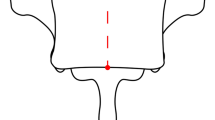Abstract
Purpose
One of the downsides of spinal correction surgery for adolescent idiopathic scoliosis (AIS) is the cessation of spinal longitudinal growth within the fused levels in growing children. However, the surgery itself has the potential to increase spinal longitudinal length by correcting the curvature. The purpose of this study was to evaluate the correlation between curve correction and increased spinal longitudinal length by corrective surgery for AIS.
Methods
This study included 208 consecutive patients (14 male, 194 female) with AIS who underwent posterior or anterior correction and fusion surgeries. Mean age at the time of surgery was 15.7 ± 3.3 years (range 10–20 years). Patients with hyperkyphosis of more than 40° were excluded. All patients had main curves in the thoracic spine (Lenke type 1 or 2). Forty-three patients underwent anterior spinal correction and fusion (ASF) and 164 underwent posterior spinal correction and fusion (PSF). The mean preoperative height was 154.7 ± 6.9 cm (range 133–173 cm). Pre and postoperative PA standing X-ray films were used to measure the Cobb angle and spinal length between the end vertebrae of the main thoracic curve, and between T1 and L5. The patients were divided into ASF and PSF groups, within which correlations between the Cobb angle correction and spinal length increase were evaluated.
Results
In the ASF group, the mean preoperative Cobb angle of the main thoracic curve was 54.9 ± 8.3° (range 41–83°) and it was corrected to 19.7 ± 9.5° (range 0–47°) with a mean correction of 35.2 ± 11.1° (range 10–74°) after surgery. The mean increase in the length of the main thoracic curve was 1.5 ± 4.6 mm (range −8 to 13 mm), and the mean increase in T1–L5 length was 16.6 ± 7.7 mm (range −3 to 51 mm). Significant correlation between the correction of the Cobb angle and increase in T1–L5 length was observed, with a correlation coefficient of 0.44. In the PSF group, the mean preoperative Cobb angle of the main thoracic curve was 58.8 ± 11.6° (range 36–107°) and it was corrected to 17.1 ± 7.6° (range 10–49°), with a mean correction of 41.7 ± 10.2° (range 21–73°) after surgery. The mean increase in the length of the main thoracic curve was 14.0 ± 5.2 mm (range 0–42 mm), and the mean increase in T1–L5 length was 32.4 ± 10.8 mm (10–61 mm). Correlation between the correction of the Cobb angle and increase in T1–L5 length was high, with a correlation coefficient of 0.64. The increase in T1–L5 length could be calculated by the following formula based on linear regression analysis: increase in T1–L5 length (mm) = correction of the Cobb angle (º) × 0.77.
Conclusion
Spinal longitudinal length was significantly increased after surgery in both the ASF and PSF groups. Correction of the Cobb angle and increase in T1–L5 length were highly correlated with each other, especially in the PSF group.





Similar content being viewed by others
References
Letts RM, Bobechko WP (1974) Fusion of the scoliotic spine in young children. Clin Orthop Relat Res:136–145
Hefti FL, McMaster MJ (1983) The effect of the adolescent growth spurt on early posterior spinal fusion in infantile and juvenile idiopathic scoliosis. J Bone Joint Surg Br 65:247–254
Winter R (1977) Scoliosis and spinal growth. Orthop Rev 6:17–20
Ylikoski M (2003) Height of girls with adolescent idiopathic scoliosis. Eur Spine J 12:288–291. doi:10.1007/s00586-003-0527-x
Stokes IA (2008) Stature and growth compensation for spinal curvature. Stud Health Technol Inform 140:48–51
Bjure J, Grimby G, Nachemson A (1968) Correction of body height in predicting spirometric values in scoliotic patients. Scand J Clin Lab Invest 21:191–192
Helms P, Bain SH, Warner JO (1986) Foot and hand length for prediction of vital capacity in scoliotic children. Spine (Phila Pa 1976) 11:746–748
Hepper NG, Black LF, Fowler WS (1965) Relationships of lung volume to height and arm span in normal subjects and in patients with spinal deformity. Am Rev Respir Dis 91:356–362
Linderholm H, Lindgren U (1978) Prediction of spirometric values in patients with scoliosis. Acta Orthop Scand 49:469–474
Torres LA, Martinez FE, Manco JC (2003) Correlation between standing height, sitting height, and arm span as an index of pulmonary function in 6 to10-year-old children. Pediatr Pulmonol 36:202–208. doi:10.1002/ppul.10239
Brookenthal KR (2002) Loss of height in scoliosis due to degree of curvature. Scoliosis Res Soc:Exhibit 15
Vedantam R, Lenke LG, Bridwell KH, Haas J, Linville DA (2000) A prospective evaluation of pulmonary function in patients with adolescent idiopathic scoliosis relative to the surgical approach used for spinal arthrodesis. Spine (Phila Pa 1976) 25:82–90
Cheung KM, Luk KD (1997) Prediction of correction of scoliosis with use of the fulcrum bending radiograph. J Bone Joint Surg Am 79:1144–1150
Takahashi S, Passuti N, Delecrin J (1997) Interpretation and utility of traction radiography in scoliosis surgery. Analysis of patients treated with Cotrel–Dubousset instrumentation. Spine (Phila Pa 1976) 22:2542–2546
Watanabe K, Kawakami N, Nishiwaki Y, Goto M, Tsuji T, Obara T, Imagama S, Matsumoto M (2007) Traction versus supine side-bending radiographs in determining flexibility: what factors influence these techniques? Spine (Phila Pa 1976) 32:2604–2609. doi:10.1097/BRS.0b013e318158cbcb
Conflict of interest
None.
Author information
Authors and Affiliations
Corresponding author
Rights and permissions
About this article
Cite this article
Watanabe, K., Hosogane, N., Kawakami, N. et al. Increase in spinal longitudinal length by correction surgery for adolescent idiopathic scoliosis. Eur Spine J 21, 1920–1925 (2012). https://doi.org/10.1007/s00586-012-2163-9
Received:
Revised:
Accepted:
Published:
Issue Date:
DOI: https://doi.org/10.1007/s00586-012-2163-9




